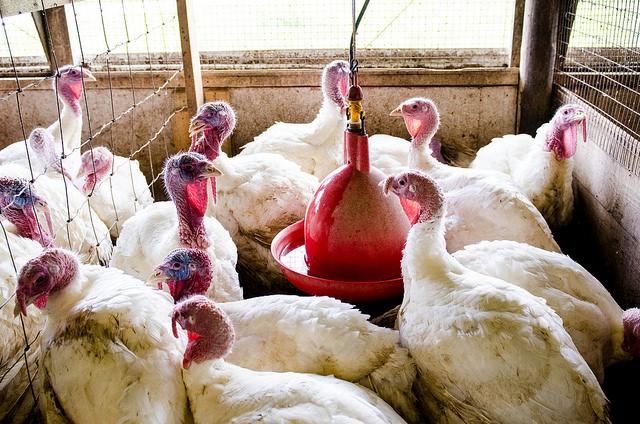Yet another Minnesota turkey farm has been hit by the highly pathogenic H5N2 avian flu virus, marking the state's eighth outbreak in just over a month, state and federal officials announced today. The new incident is in the same county where one of two outbreaks was reported yesterday.
In addition, an H5 strain of avian flu has hit a turkey farm in southern Ontario, and H5N6 has been detected in a village flock in Vietnam, health authorities reported yesterday.
Kandiyohi County struck twice
The new Minnesota outbreak—the fifth one reported in the past 6 days—is on a farm with 30,000 turkeys in Kandiyohi County in the west-central part of the state, the US Department of Agriculture (USDA) announced. Yesterday officials announced an outbreak on a Kandiyohi County farm with 26,000 turkeys. The county leads the state in turkey production, according to the Minneapolis Star Tribune, and Minnesota leads the nation in turkey production.
As in the previous outbreaks, the USDA and state officials have quarantined the affected farm and surrounding area and will euthanize all the surviving turkeys to prevent further spread of the virus, the agency said. Poultry within a few miles of the site will be tested.
State law does not permit the release of the names or locations of affected farms. Statements from the USDA and the Minnesota Board of Animal Health (MBAH) today did not list how many turkeys died, the distance between the two Kandiyohi County farms, or whether there is any known connection between them.
As in the previous Minnesota outbreaks, increased deaths at the new outbreak site prompted testing by the University of Minnesota Veterinary Diagnostic Laboratory, with confirmation by the USDA's National Veterinary Services Laboratories in Ames, Iowa.
About 30 USDA researchers came to Minnesota this week to help investigate the outbreaks, joining about 20 state workers, the Star Tribune reported yesterday, quoting Bill Hartmann, DVM, MS, state veterinarian with the MBAH.
The first Minnesota H5N2 outbreak was reported in Pope County on Mar 5, marking the virus's Midwestern debut after several detections in Washington, Oregon, and Idaho earlier in the winter. Stearns County, which adjoins Kandiyohi, has had three outbreaks.
In March the H5N2 virus also struck two Missouri turkey farms and one in Arkansas, along with a backyard poultry flock in Kansas, and an outbreak on a South Dakota turkey farm was reported Apr 2.
Officials say the virus can be spread by wild birds, which can carry it without showing signs of illness and shed it in their feces. But exactly how it is getting into turkey barns has not been discovered.
The virus has not been known to infect humans, but the Minnesota Department of Health is advising poultry workers on precautions against any infection risk.
Canadian outbreak
In Canada, a farm near Woodstock, Ont., experienced sudden death in its turkeys over several days recently, and initial tests conducted Apr 5 at the Animal Health Laboratory at the University of Guelph confirmed H5 avian flu, the Canadian Food Inspection Agency (CFIA) said in a news release yesterday.
Authorities have placed eight farms in southern Ontario under quarantine because of the outbreak, the Canadian Press reported today. The story said that 7,500 birds have died on the farm and the remainder of the 12,000-turkey flock will be euthanized to help control the outbreak.
Further testing is under way to determine the pathogenicity of the virus and its exact strain. Results are expected within days, the CFIA said in the release.
Canada has not confirmed avian flu in poultry since early February, when H5N1 struck a backyard chicken flock in Chilliwack, B.C. In December, H5N2 was responsible for at least 10 outbreaks on British Columbia poultry farms, and that strain infected a small flock of mixed poultry at Langley, B.C., in early January.
H5N6 strikes in Vietnam
In Vietnam, highly pathogenic H5N6 was confirmed in a village flock in Nghe An province in the northern part of the country, according to a report from the country's chief veterinary officer to the World Organization for Animal Health (OIE).
The report did not specify how many poultry were affected, but it said all 318 birds would be culled to curb the outbreak. The incident occurred from Mar 12 through Mar 14.
A separate H5N6 outbreak occurred during the same period and affected a 670-bird village flock in neighboring Thanh Hoa province, but that OIE report was posted Mar 19.
See also:
Apr 7 USDA statement
MBAH updates
Apr 6 Star Tribune story
Apr 6 CIDRAP News story on recent Minnesota outbreaks
Apr 6 CFIA news release
Apr 7 Canadian Press story
Apr 6 OIE report
Mar 19 OIE report



















